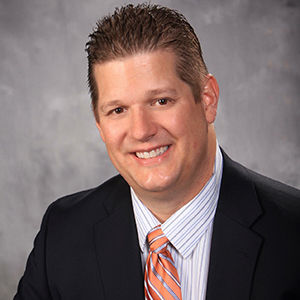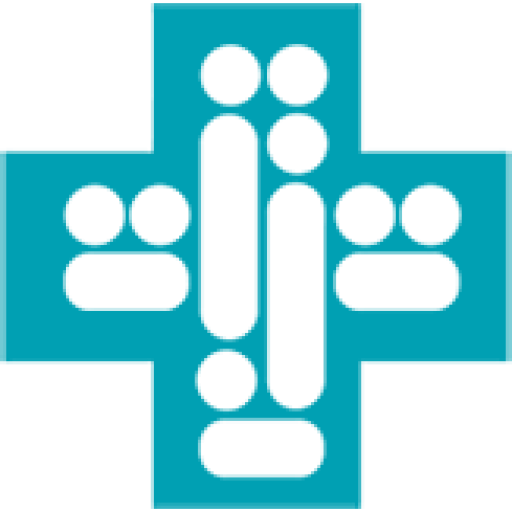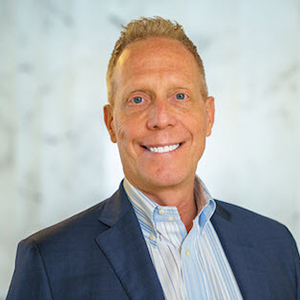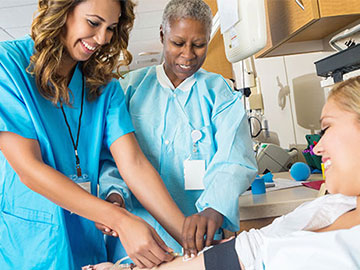In this Article


Written and reported by:
Lisa Jaffe
Contributing Writer
We’re probably all familiar with dental hygienists and physical therapists. But what about respiratory therapists or medical transcriptionists? All are examples of allied health professionals. But the list of allied health roles is much, much longer. Just what are allied health professionals? What do they do? And how can you become one?
What Is Allied Health?
Allied health is defined in federal code as healthcare professions outside of nursing, dentistry, and medicine. However, like them, the allied health professions use evidence-based practices to care for patients. These professionals have a degree or certificate from a school and work in a setting where people receive healthcare services.
“The rules for education and licensure depend on the position, as well as state law,” says Lorna Frazier-Lindsey, director of information and communications at the Commission on Accreditation of Allied Health Education Programs (CAAHEP). The commission accredits a variety of allied health programs, including those for diagnostic sonographers, surgical technicians, and emergency medical technicians.
Allied health professionals may work directly with patients, or they may serve in administrative roles. Among some of the possible careers you can pursue are:
- Dental Lab Technician:
- This professional works with dentists to create dentures, partial dentures, crowns, veneers, and orthodontic appliances. They may specialize in one of these areas.
- Health Unit Coordinator:
- In this role, a person is responsible for coordinating communication among departments, physicians, and other team members. They may do patient intake work, keep records, and order transcriptions.
- Healthcare Administrator:
- A healthcare administrator can oversee an entire hospital, a hospital department, or a medical practice. They’re in charge of hiring and ensuring their hospital or unit meets all regulatory requirements and runs smoothly, efficiently, and safely.
- Medical Transcriptionist:
- This professional takes the notes of physicians or other medical personnel and transcribes them into written reports. They may also do this with tape-recorded notes.
- Long-Term Care Manager:
- This healthcare manager is responsible for directing care in hospital units or separate facilities that care for patients who have overcome an initial acute illness and need to recover, or who need rehabilitation.
- Health Educator:
- These educators can work directly with patients to help them learn to manage an illness or in a community setting to educate people about public health concerns. They may also train other healthcare professionals on how to best educate their patients.
- Dietitian/Nutritionist:
- These professionals work in many settings, including private practice, long-term care facilities, and hospitals. They help determine the best diets for patients with health problems or for people who are simply looking to improve their health.
- Pharmacist:
- Pharmacists don’t just fill prescriptions, they also educate patients and other healthcare professionals about drug options and potential interactions. They can work in hospitals, nursing homes, or pharmacies.
- Audiologist:
- Audiologists work with patients of all ages to help diagnose and treat hearing disorders, balance problems, and auditory processing problems. They can work in schools, hospitals, private practice, or long-term care facilities.
- Certified Nursing Assistant:
- These professionals assist nurses in patient care, including taking vital signs, feeding patients, and in some medical procedures, and monitoring a patient’s behavior and condition.
History of Allied Health
Some allied health professions have existed for centuries. There’s evidence that dietitians were advising people about food in the mid-1800s and that occupational therapists were helping the injured and disabled 200 years ago. But they weren’t called allied health professions until after World War II, when their numbers began to grow rapidly.
At that time, there was a push to offer more treatment options outside of hospitals to reduce costs and expand access to medical care. Creating these new professions and setting education and training standards enabled the healthcare industry to expand and reach more patients. Over time, they became known as allied health, a distinct group of professions separate from nursing, dentistry, and medicine.
They were given legal recognition with the Allied Health Professions Personnel Training Act of 1966. Today, they make up as much as 60% of the healthcare workforce in the United States, with strong job growth projected over the next decade as the population ages and current professionals retire.
Skills and Traits of Allied Health Professionals
Different healthcare roles can require different skills and personality traits. Here are a few that apply to most allied health professions.
Compassion
Frazier-Lindsey says this is a top trait for healthcare workers. Those who work directly with patients may care for people are very sick and in discomfort or pain. Others may fear a procedure or be anxious about a diagnosis. Being able to empathize and help ease these feelings will help professionals care for patients.
Math and technological skills
Some allied health roles require math, and respiratory therapy is one of them, says Laher. Most allied health professions also have some technological aspect to them. This requires being comfortable with evolving technologies and willing to learn new ones as they are developed.
Critical thinking
Douglas S. Laher MBA, CAE, CMP, RRT, FAARC, chief operating officer of the American Association for Respiratory Care, emphasizes critical thinking and lifelong learning as top traits. Critical thinking skills are required to solve problems and make decisions that are in the best interest of the patient’s health and safety. And because healthcare is a constantly evolving field, you’ll need to embrace learning throughout your career.
Physically fit
Some allied health professionals need to maintain a level of fitness to handle the requirements of their job. For instance, nursing assistants move and lift patients, and surgical assistants and technicians need to be able to stand relatively still for the length of a surgery. Other roles require people to be on their feet all day and moving around.
Where Do Allied Health Professionals Work?
The places where allied health professionals work are as varied as the jobs, and different facilities may appeal to different people.
Hospitals
These are usually busy places, especially the larger facilities, academic medical centers, and those in large cities. Allied health professionals who work in hospitals include pharmacists and pharmacist technicians, nursing assistants, occupational therapists, and surgical assistants. Fewer allied health roles are available in rural hospitals, but they may be an option for those who like the idea of working in acute-care settings in a less hectic environment.
Private Practices
These can be large multi-disciplinary practices that employ their own pharmacists, audiologists and health information professionals. Or they can be solo practices with a single doctor and a health administrator responsible for all of the back-office duties, such as medical transcription and health coordination. There are private practices that fit in between in terms of size. These may employ more allied health professionals.
Dental Offices
Many dentists have solo or smaller practices, along the lines of small medical practices. The exception might be university practices that participate in training new dentists. These settings may have a larger number of hygienists, assistants and lab technicians.
Clinics
Clinics may be small or large, private or dedicated to public health. In large cities, public health clinics can be very busy and require foreign language skills for patient-facing roles. Clinics can also be a specific unit in a larger facility, such as a diagnostic imaging clinic within a hospital, where radiography and sonography technicians may work.
Laboratories
These facilities can be staffed with just a single person or several. Hospitals and some large clinics and private practices have their own labs to handle diagnostics that may involve blood and other body fluids or biopsies of body tissue. Labs are also places where dentures and other dental appliances are made.
Long-Term Care Facilities
These facilities care for patients who are discharged from a hospital but need more care before they can go home, or who are no longer able to care for themselves at home. Long-term facilities can be large or small. Most rely heavily on allied health professionals—including nursing assistants, physical and occupational therapists, dieticians and administrative personnel.
Rehabilitation Hospitals
These hospitals often share space with long-term care facilities but are focused on improving a patient’s health so they can go home. They, too, rely on allied health professionals, including occupational, physical, and speech therapists, nursing assistants, and administrative professionals.
Schools and Fire Stations
These and other public spaces may make use of allied health professionals. Schools may employ audiologists or optometrists to test students, and fire stations almost always include staff trained as emergency medical technicians (EMTs).
Other government and business entities—accounting and consulting firms, government agencies, academic institutions, software companies, and non-profits—also employ some allied health professionals. This is particularly true for those involved in health information management and the more technical aspects of healthcare, says Keith Olenik, MA, RHIA, CHP, chief membership officer of the American Health Information Management Association (AHIMA).
How Can I Pursue a Career in Allied Health?
If the allied health professions interest you, use these steps as a guide to pursue a career.
- Define your career goals.
Do you want to work with a lot of different people in a profession in which every day is different? Do you want to work as part of a team or rise to be a manager? Do you like the idea of working directly with patients, or do you prefer to be behind the scenes in administration? Answering these questions could help you narrow your career choices.
- Decide what kind of education you want to pursue.
Do you want to find a job relatively quickly, or is in-depth learning through a multi-year education program something that you look forward to? Some allied health roles, like medical transcriptionist or health unit coordinator, don’t require a great deal of post-high school education to get started. Others, like pharmacist, require a four-year bachelor’s degree followed by a PhD, which can take two to three more years. While longer education programs cost more, they also generally lead to careers with higher salaries.
- Find out what degrees or certificate programs are available.
Are they accredited? Frazier-Lindsey says choosing an accredited program and school is important because they tell future employers that you received a quality education. Many employers don’t recognize education from non-accredited schools or programs, which could make it difficult to find the job you want.
- Gain experience.
Many allied health fields require experience before you can work. The good news is that many education programs include clinical time or training and help students land internships at local health facilities. If you want to work in a specific setting, such as a hospital or physician’s office, make sure you spend clinical time in that workplace.
- Consider earning a certification.
While some roles don’t require a certification, these credentials are available in almost all allied health professions and earning one can open the door to advancement and higher pay. Certifications can also allow you to specialize with skills and knowledge that can help you stand out from the competition. Professional associations often offer certifications.
If you narrow your options but still can’t decide on a career, consider volunteering or job shadowing in a profession you’re interested in. Or interview someone in the role about their path to the job, what they like about it, and what they see as the requirements to be successful.
Resources for Allied Health Professionals
You can learn more about allied health professions from these organizations:
- Commission on Accreditation of Allied Health Education Programs (CAAHEP):
- Evaluates educational programs for certain allied health professions, including sonography technicians, surgical technicians, exercise physiology, and personal training
- Association of Schools Advancing Health Professionals (ASAHP):
- Provides resources for schools and programs that educate and train allied health professionals
- American Association of Medical Assistants (AAMA):
- Provides information on continuing education, careers, and potential employers for medical assistants
- American College of Healthcare Executives (ACHE):
- Offers conferences, training, specialized credentials, and career information for healthcare executives
- Association for Healthcare Documentation Integrity (AHDI):
- Provides information on careers, education, and certification for medical transcriptionists
- American Occupational Therapy Association (AOTA):
- Provides resources for patients, therapists, and those interested in becoming occupational therapists
- American Association for Respiratory Care (AARC):
- Provides information, resources, conferences, and education for respiratory therapists and technicians
- American Health Information Management Association (AHIMA):
- Focuses on certification of health information technology professionals
- American Medical Certification Association (AMCA):
- Offers certification and continuing education for several administrative and clinical professions, including those related to electronic health records, nursing assistants, and mental health technicians
- National Athletic Training Association (NATA):
- Provides career information for certified athletic trainers and advocates for the profession, and provides information to the public about the profession
- Society for Diagnostic Medical Sonography (SDMS):
- Offers resources, including continuing education and career information
- American Physical Therapy Association (APTA):
- Provides information on careers, education, and practice building for physical therapists
- National Board for Certification in Dental Lab Technology (NBC):
- Offers certification for dental lab technologists
- Healthcare Financial Management Association (HFMA):
- Offers education, conferences, and other tools for financial managers of healthcare organizations
- American Medical Technologists (AMT):
- Offers certification for a variety of allied health professions, including dental assistants, phlebotomy technicians, and medical assistants
- National Healthcareer Association (NHA):
- Offers certification for professionals such as pharmacy and EKG technicians
- National Center for Competency Testing (NCCT):
- Provides certification for phlebotomy technicians, medical office assistants, and billers and coders
- National Association of Emergency Medical Technicians (NAEMT):
- Serves the professional interests of emergency medical technicians with advocacy at the state and federal level, and information on careers and continuing education
- American Dental Assistants Association (AADA):
- Advocates on legislative issues related to the profession and provides education and career information for those in and interested in the profession
- The American Academy of Audiology (AAA):
- Provides education and materials, conferences, and research related to audiology

With professional insight from:
Doug Laher, MBA, RRT
Chief Operating Officer, American Association for Respiratory Care

Lorna Frazier-Lindsey
Director, Information & Communications, Commission on Accreditation of Allied Health Education Programs

Keith Olenik, MA, RHIA, CHP
Chief Membership Officer, American Health Information Management Association
You may also enjoy:



